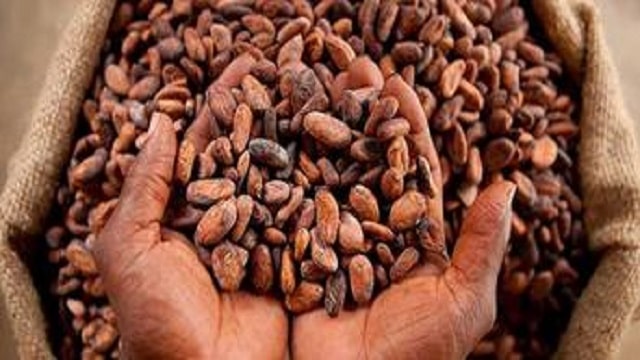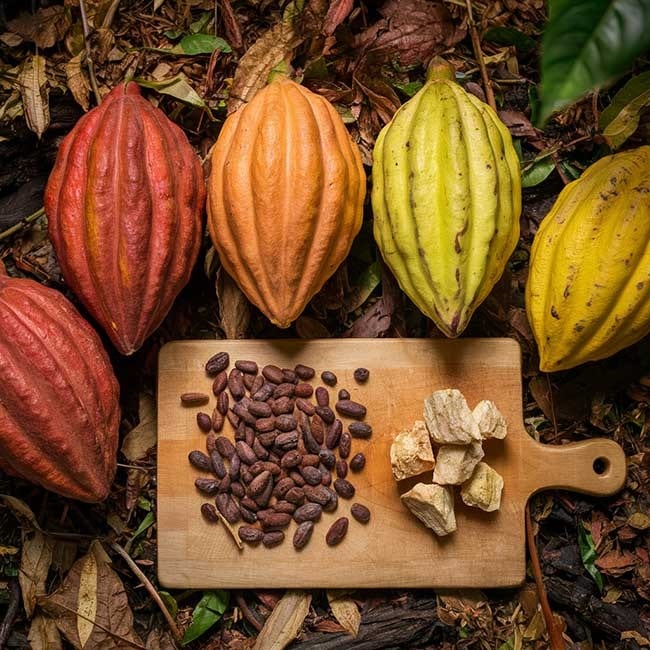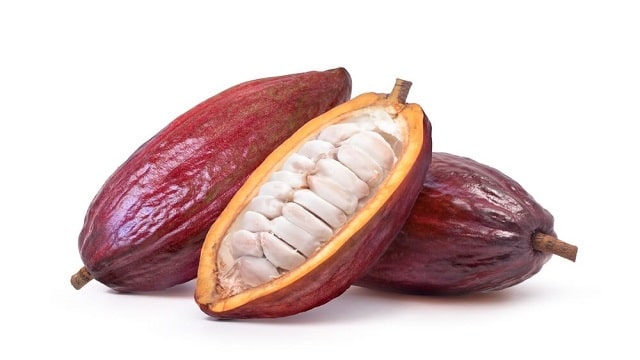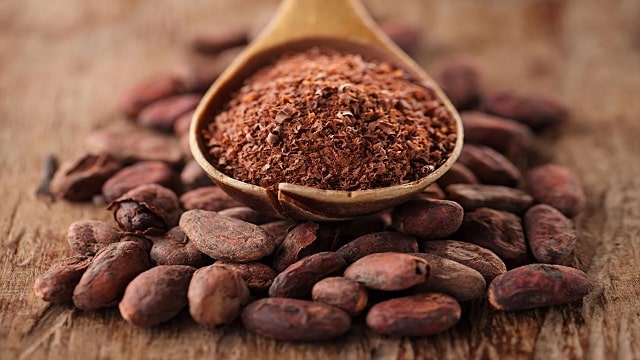Cocoa is an Amazonian tree that produces a fruit loved worldwide, from which chocolate is obtained. Its history is ancient, and its culinary uses extend from baking to the traditional Mexican mole. It brings flavor to the table and benefits to our health.
Cocoa is a tree, a bean, and the name given to the main ingredient in chocolate. We can find it on the market in powder form or in nibs (small pieces of cocoa beans), and it stands out in those chocolate bars with high percentages of more than 85%. In any of its forms, it contributes to our well-being not only for its flavour and its potential to make an unforgettable chocolate cake but also because it takes care of our cardiovascular health and our mood. It is a real pleasure to delve into this ingredient from tropical regions, its aromas, properties, and culinary uses.
What is cocoa?
Cocoa is the name given to the Amazonian tree ( Theobroma cacao L. ) that has a thick-shelled fruit nicknamed the same. After the indispensable fermentation process, and not always obligatory roasting, its seeds housed in the white pulp of the fruit become the main ingredient of chocolate.
The tree grows in tropical, hot, and humid climates and is 5 to 8 meters tall. Its trunk is languid and the large leaves with a wide base and elongated tip cover the entire crown. Contrary to what usually happens, the ivory and pink flowers grow in clusters directly from the trunk. The fruits are presented in reddish-brown and ochre tones. For many diners, the encounter with the pod is an astonishing experience since the fermented and roasted grain has nothing to do with that raw grain wrapped in a white and glutinous pulp that is presented raw inside the shell.
Cocoa plantations can be found throughout Central and South America, from Mexico to Brazil, with the most notable cocoa in Peru and Ecuador. In Africa, the largest distribution is in the Ivory Coast, and it grows more discreetly in tropical Asian regions such as Malaysia and Indonesia.
Given the diversity of origins and, as we will see later, the types of cocoa, we may wonder what good cocoa is. For Nerea Prieto, chocolate taster and member of the Bean to Bar Spain Association: “A good cocoa is one that has organoleptic qualities among which complex aromas stand out in a wide range that includes fruity, herbal and even floral nuances. They are the so-called fine aroma cocoas.” What we do not know is whether aroma was also a decisive factor in its origins, when cocoa was presented in liquid form in the hands of emperors.
Origin and history of cocoa
Today, cacao ceremonies have revalued the tribal origins of this food. In fact, it is likely that one of the most famous drinks in the history of gastronomy is the mixture of dried and ground cacao beans with water, which was drunk by the Olmecs, and considered the first civilization on the American continent.
A concoction that, far from dissipating, transcended the Mayan and Aztec empires, civilizations among which it continued to evolve from a cold drink to a hot drink and was found with spices and condiments. Its importance was such that it became one of the most esteemed allies of the emperor Moctezuma, who seems to have enjoyed the aphrodisiac power of the cocoa drink, myth or not.
Although it is not possible to determine an exact date, it is believed that it arrived in Europe around 1520 and that Hernán Cortés, who described it as “a fruit like almonds, which they sell ground, and they value it so much that it is used as currency throughout the land, and with it all the necessary things are bought in the markets and other places”, played a fundamental role in its expansion.
Surrounded by a medicinal and exotic atmosphere, its sweetening facilitated its expansion from Spain to France, Italy, and the rest of Europe. However, it had to wait almost 3 more centuries, until the beginning of the 19th century, for the Industrial Revolution to start producing the solid version that laid the foundations for our valued chocolate bars.
Types and varieties of cocoa
The nature of cocoa production means that the variety and types of this bean are extremely extensive. Even so, there is a first classification that allows us to get a first look at the geography and variety of the plantations. These are the three main types of cocoa: Forastero Cocoa, Criollo Cocoa, and Trinitario Cocoa.
Foreign Cocoa

Forastero or Amazonian cocoa is the most common type, characterized by an intense, bitter flavor and low acidity. It represents around 70% of world production. Much of its success is due to the fact that it is highly resistant to diseases and has a high fruit production. The only drawback, as occurs with crops of these characteristics, is that it compromises the organoleptic result.
The bean expanded along with the creation and popularization of chocolate towards the end of the 19th century. Today, the main crops are found on the African continent; Ivory Coast, Ghana, Cameroon, Sao Tome, and to a lesser extent in South America, Peru, Ecuador, Colombia, and Brazil.
Criollo Cocoa

Criollo cocoa is highly appreciated for the quality of its fruit, however, it is not very fruitful and is therefore not ideal for the production of cocoa and derivatives on a large scale.
Physiologically, it differs from the rest because it has rounder and slightly flatter seeds with violet hues. The most notable feature of this variety is its fruity aroma and hints of nuts. Due to its characteristics, it is a type of cocoa intended for specialty chocolate products such as bonbons. It represents approximately 12% of world production.
It is mainly cultivated in Central America: Mexico, Guatemala, and Nicaragua. Although there are some crops in Colombia, Caribbean islands, Trinidad, Jamaica, Madagascar, and Java.
Trinitario cocoa

This variety of cocoa is the result of crossing Criollo and Forastero in order to enhance the qualities of both versions: an aromatic and easy-to-grow cocoa.
And indeed, this variety is more resistant to disease and has a more subtle flavour than the forastero, while presenting more nuances than the criollo. The main growing regions are Trinidad, Java, Sri Lanka, Papua New Guinea, and Cameroon. It represents only 3 to 5% of total world production.
Other types of cocoa
Although this classification reveals what would otherwise be a very complex tangle, Jaume Martorell, Co-founder of Maüa chocolates and president of the Bean to Bar Spain association, states that there are many other varieties of cocoa due to, among other factors, the following: ” There is great genetic variability in cocoa crops. The same cocoa seed planted in a different tropical ecosystem will express its attributes in a different way to the ecosystem of origin, without taking into account all the hybridization processes that occur in each country.”
The nature of the plantations, the work of harvesting and fermentation, as well as the roasting processes, can turn the most exquisite cocoa into a standardized and homogeneous version of chocolate, or on the contrary, into a more or less earthy morsel, full of particular and unique nuances for that bean, from a certain origin and time of harvest. In addition, Jaume states that: “the reality of the sector that is spread throughout developing countries does not coexist today with common protocols or parameters, which promotes, to a greater extent, that the diversity continues to be very extreme between some beans and others.”
Nutritional value of cocoa
The nutritional value of raw cocoa can vary slightly depending on the crop of origin. Likewise, its calorie or fat content is different when it is raw or when it has already undergone some processing process, such as that used to obtain cocoa powder. Below, we compile a nutritional table with the average values of cocoa nibs, the purest form of cocoa easily available in supermarkets and specialist shops.
- Calories: 635 kcal
- Fats: 58 g
- Saturated fats: 36 g
- Proteins: 13 g
- Carbohydrates: 9 g
- Iron: 13.9 mg
- Calcium: 128 mg
Properties and benefits
- Cocoa is one of those fascinating foods that, thanks to its numerous components such as flavonoids, antioxidants and minerals, provides a long list of health benefits. The areas in which it has the most positive influence are the cardiovascular system and the central nervous system, including everything from improving concentration to mood.
- Protect your cardiovascular health
- Cocoa is rich in polyphenols that benefit cardiovascular health in multiple ways. It has antihypertensive action and its consumption increases HLD levels, which is related to a lower incidence of cholesterol plaques in the arteries and consequently better cardiovascular health.
- Increase your concentration
- Cocoa flavonoids have a neuroprotective role, stimulating memory and learning ability. The main factor responsible for this effect is epicatechin, a flavonol with antioxidant action capable of reversing age-related memory loss.
- Improve your mood
- Cocoa contains tryptophan, a precursor of serotonin, known as the neurotransmitter of well-being, and also promotes the production of endorphins, a type of neurotransmitter associated with pleasure. As a result, the consumption of cocoa or chocolate with a high percentage of cocoa is related to an improvement in mood.
- Protects against diabetes
- Type II diabetes is characterized by insulin resistance, resulting in unhealthily high blood glucose levels. Studies have shown that cocoa flavonoids have the ability to improve insulin sensitivity and glucose tolerance in cases of diabetes. This effect improves the diabetic condition and makes cocoa a great ally in preventing the development of diabetes.
Contraindications of cocoa
- Cocoa, and especially chocolate, its most famous derivative, is shrouded in all kinds of myths. From the relationship between chocolate and acne to that of chocolate and weight gain or even that of chocolate consumption and increased cholesterol.
- The truth is that chocolate is made up of a basic formulation of cocoa and sugar, which can be accompanied by many other ingredients, which, beyond cocoa, can have some health implications other than pure cocoa.
- However, when we refer to products such as unsweetened cocoa powder or cocoa nibs, the most common and least processed commercial forms, we can assure that their consumption does not imply the appearance of acne, as has been shown by numerous studies that relate it to hormonal disorders and genetic factors, nor is the consumption of cocoa related to weight gain. In the case of cholesterol, far from increasing it, a daily portion of cocoa, such as in the form of an ounce of chocolate with more than 85%, is related to the increase of good cholesterol HLD and with better cardiovascular health.
- In conclusion, cocoa consumption does not present any major contraindications other than the recommendation of moderate consumption due to its high caloric and saturated fat content.
Recipes with cocoa and its uses in cooking
- It is worth mentioning that chocolate is the most famous culinary use of cocoa. Cocoa for hot chocolate, and chocolate bars, but not exclusively. Cocoa nibs, the raw, roasted, and peeled cocoa bean are used in pastries for decoration and sold in shops to young people who rediscover it as a healthy snack during their study sessions. We can also find 100% cocoa pastes that are used to make ice cream or the classic chocolate coatings.
- Not to mention the whole world of possibilities that exists when we delve into cocoa, chocolate, and savoury recipes, from cuttlefish or squid with chocolate to game meats such as hare, wild boar, deer, or partridges, of course, the classic and traditional mole poblano made with chicken and dark chocolate is all a discovery for the palate. More unexpectedly, the use of chickpeas with cocoa to create a spreadable cocoa cream that is healthier than the commercial version is presented.
- Within everyone’s reach are the essential sweet cocoa recipes as juicy as the brownie, a homemade chocolate cake, or the chocolate and truffle cake, a celebration winner on par with Emperor Moctezuma’s cocoa drink.
